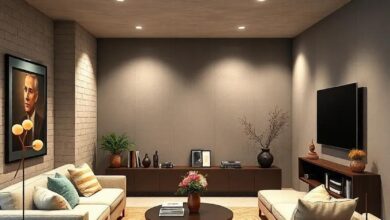Seamless Spaces: Embracing Open Concept Living Rooms and Kitchens with Stylish Sliding Doors

In today’s ever-evolving world of interior design, the boundaries of customary living spaces are becoming increasingly fluid, giving rise to a trend that celebrates openness and connection: the seamless integration of living rooms and kitchens. “Seamless Spaces” invites you to explore the allure of open concept layouts, where barriers dissolve and functionality thrives. At the heart of this trend lies the stylish sliding door—an elegant solution that not only enhances the aesthetic flow between spaces but also allows for flexibility and versatility in how we live and entertain. Join us as we delve into the transformative power of open concept design, examining how thoughtful choices in architecture and decor can create harmonious environments that invite social interaction while retaining a sense of individuality.
A welcoming Transition: The beauty of Sliding Doors in Open Concept Spaces
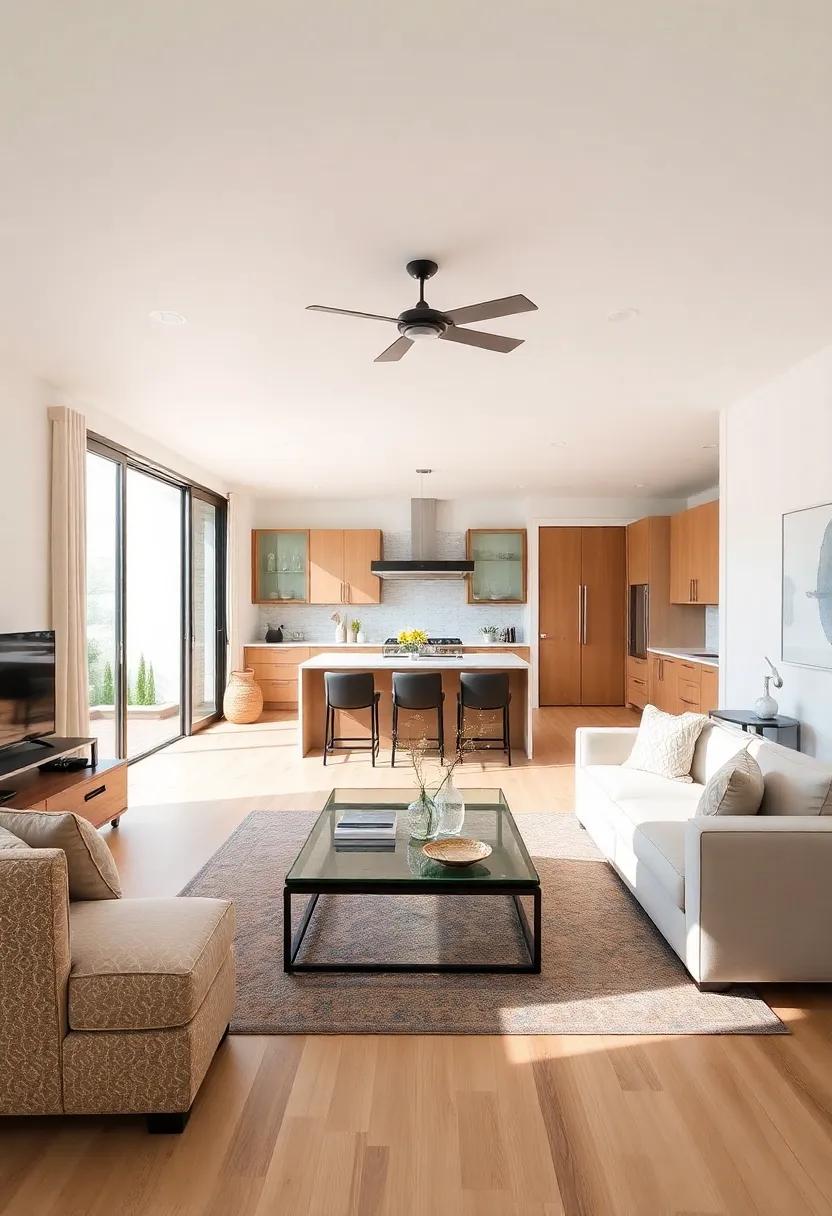
The graceful pivot of sliding doors brings a transformative essence to open concept spaces, artfully blending functionality with aesthetics. Unlike traditional doors, which can disrupt sightlines and flow, sliding doors create a fluid transition between the living room and kitchen. Their ability to effortlessly slide open or closed means you can enjoy togetherness while cooking or entertain guests without feeling confined. Homeowners can choose from a variety of materials and finishes, enabling them to tailor the look to their unique décor, be it sleek glass, warm wood, or even bold metal frames.
In addition to their visual appeal, sliding doors also enhance the practical aspects of daily living. They can allow for greater flexibility, as thes doors can open to reveal expansive spaces when hosting gatherings, or provide privacy when one desires a quieter atmosphere. Consider the following benefits of incorporating sliding doors into your home:
- Space Efficiency: No need for clearance space, allowing for furniture placement against the wall.
- Natural Light: Expansive glass panels invite sunlight, brightening up both rooms.
- Design Versatility: Easily complements various interior themes, from modern minimalism to rustic charm.
Inviting Nature Indoors: Incorporating Natural Light with Sliding Glass Walls
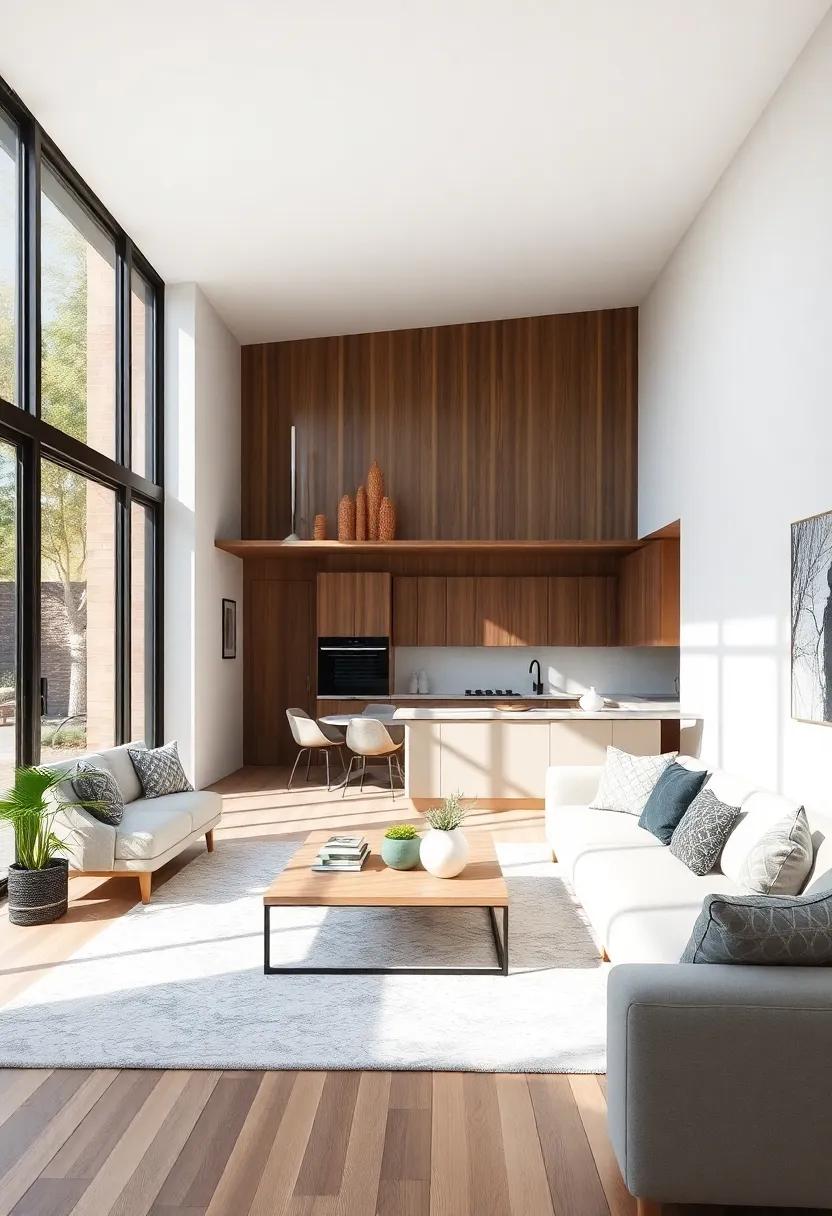
Infusing your living space with the essence of the outdoors can transform your home into a serene oasis, and sliding glass walls provide an exquisite solution. These expansive panels not only invite natural light to flood your interiors but also create a fluid connection between your indoor and outdoor environments. Imagine hosting a gathering where the aroma of fresh flowers wafts in through unobstructed views,enhancing the enjoyment of every meal and conversation. With breathtaking vistas and a tranquil ambiance just a slide away, your home becomes a sanctuary that reflects nature’s beauty.
when selecting sliding glass walls, consider various design elements that compliment your aesthetic.A few factors to think about include:
- frame Materials: Choose between sleek aluminum or warm wood finishes.
- Glass Options: Opt for energy-efficient glazing to enhance insulation.
- Mechanism Type: Decide on pocket, bi-fold, or multi-slide openings to suit your space.
Incorporating these walls can considerably elevate your lifestyle, with exquisite designs effortlessly merging your interiors with lush gardens or panoramic landscapes. They serve as an artistic statement that fosters openness and encourages a daily communion with nature.
Creating Flow: How Sliding Doors Enhance Movement Between Rooms
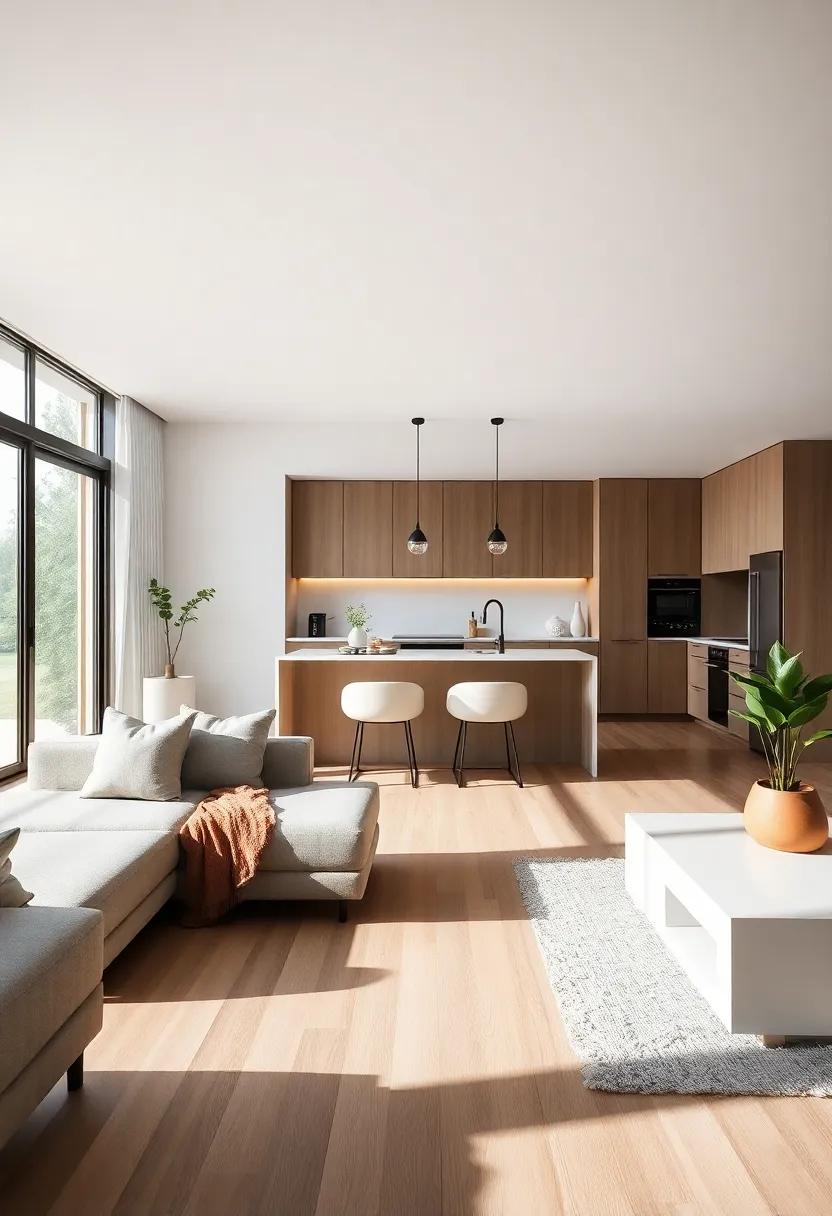
Sliding doors not only function as practical entryways but also serve as *artistic statements*, effectively transforming the way we experience interconnected spaces. with their sleek lines and *obvious designs*, they create an illusion of continuous flow, encouraging natural light to cascade through rooms, thus enhancing the overall atmosphere. The ability to slide open or close also allows homeowners to easily *adapt their living spaces to different moods and occasions*, whether it’s hosting family gatherings or seeking a moment of solitude. Additionally, sliding doors can *unify distinct areas*, creating a seamless transition between the living room and kitchen, which promotes a sense of community and interaction.
Incorporating these versatile architectural features can also elevate the aesthetic appeal of your home. With a wide variety of styles and finishes available, from *minimalistic glass panels* to *wooden frames*, homeowners can select options that resonate with their design philosophy. Some advantages of sliding doors include:
- Space Efficiency: Unlike traditional hinged doors,sliding doors take up no extra floor space when open,making them ideal for smaller areas.
- Enhanced Natural Light: Large glass panels allow sunlight to fill spaces,reducing the need for artificial lighting.
- Increased Ventilation: many sliding doors can be partially opened to create a *breeze*, improving airflow and comfort.
Stylish Storage Solutions: Clever Ideas for Open Living Areas
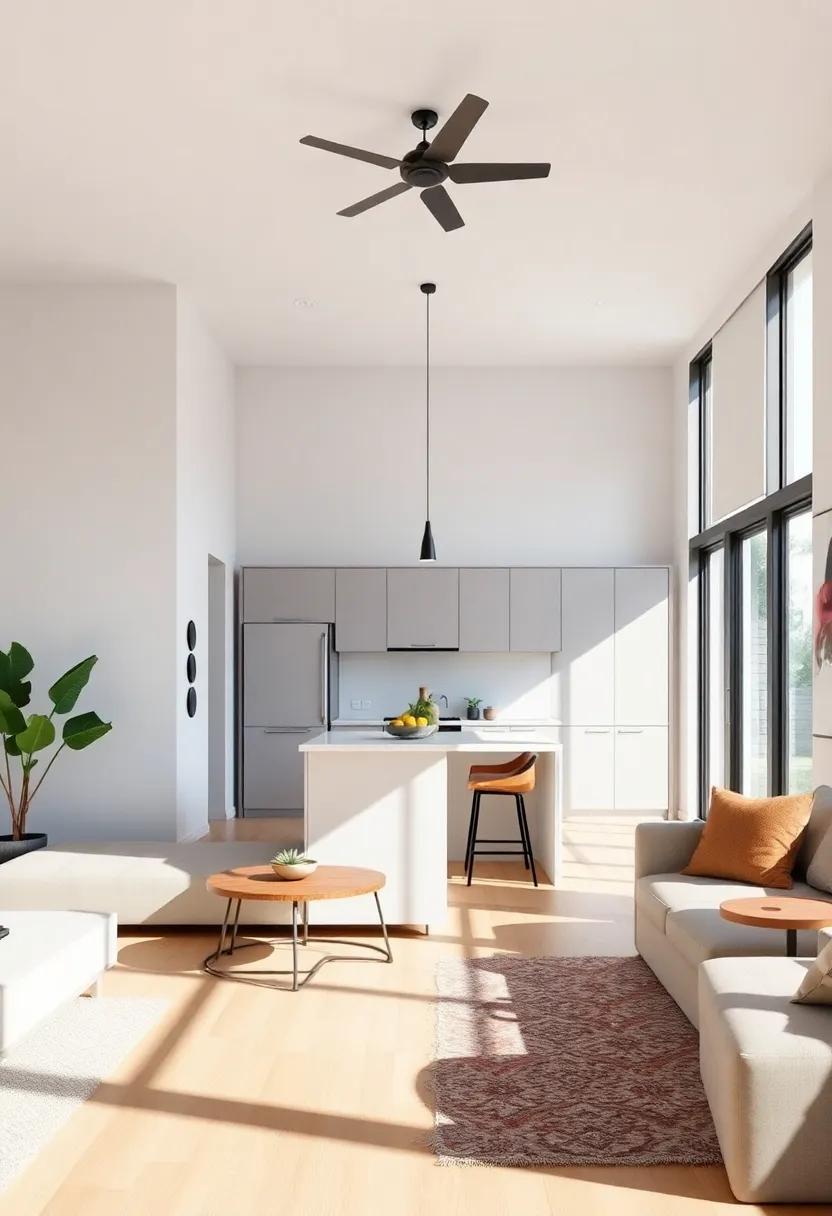
In the quest for a harmonious open living area, thoughtful storage solutions can make all the difference. Embracing multi-functional furniture is one way to enhance your space while keeping it stylish. Consider the following options:
- ottomans with Hidden Storage: Perfect for stashing away blankets or books while doubling as extra seating.
- Sleek Shelving units: Open shelves not only display your favorite decor but also create a sense of airiness.
- Built-in Cabinets: Custom cabinetry can blend seamlessly with your decor, providing ample storage without sacrificing style.
Another innovative approach is to harness the power of vertical space. Think beyond traditional furniture arrangements and explore creative wall storage. Here are some inspiring ideas:
- Wall-mounted Pegboards: Great for organizing kitchen utensils or office supplies, keeping everything within reach.
- Floating Shelves: Ideal for displaying art and plants while keeping floor space clear.
- Modular Storage Units: Adaptable pieces that can be reconfigured to suit your changing needs.
Color and Texture: Coordinating Palettes in Open Concept Designs
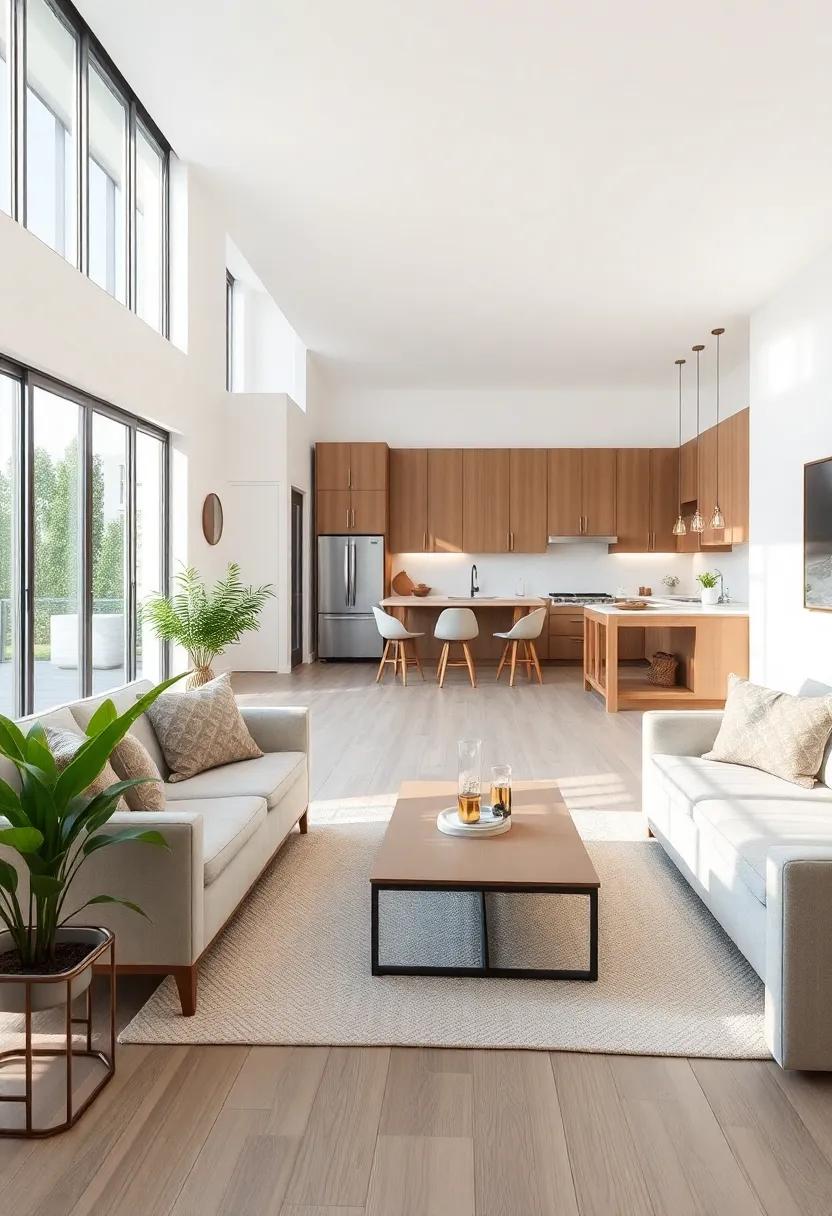
When harmonizing colors and textures in an open concept living space, consider the flow between the kitchen and living room areas. A cohesive palette strengthens the visual connection, making the space feel integrated. Neutral tones such as soft beiges, whites, and greys can serve as a backdrop, allowing for bolder accents in furnishings and decor. Incorporate elements like natural woods and stone finishes to add depth and warmth,fostering an inviting atmosphere.
Additionally,layering textures can elevate the aesthetic appeal of your open concept layout. Consider mixing smooth surfaces with richer materials,such as:
- Velvet cushions on a crisp linen sofa
- Marble countertops paired with rustic wood dining tables
- Metallic accents in light fixtures against matte finishes
This intentional contrast not only enriches the design but also guides the eye throughout the space. The right balance can highlight architectural features and create zones without the need for physical barriers, making your home feel spacious and well-curated.
The Art of Separation: Utilizing Sliding Doors for versatile Spaces
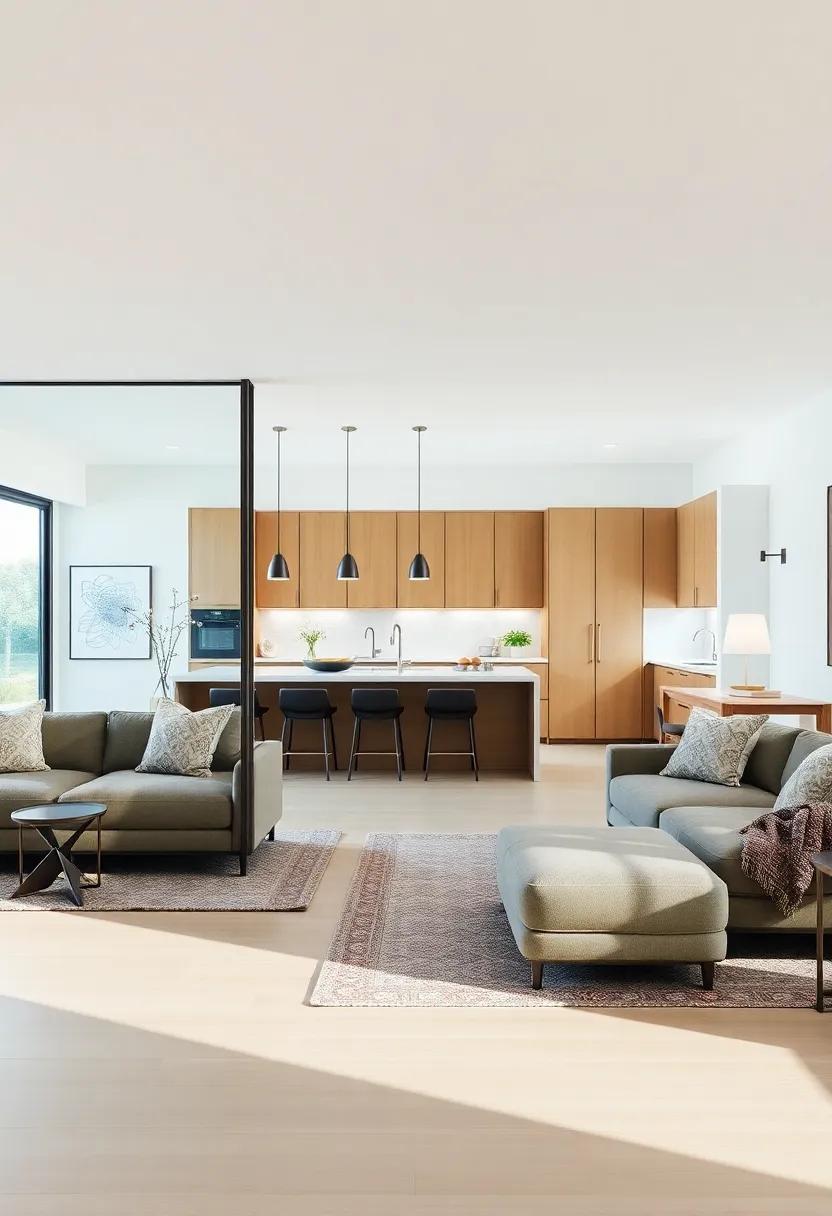
Sliding doors serve as an elegant solution for crafting multi-functional areas in modern homes.By effortlessly transitioning between spaces, they provide both functionality and aesthetic appeal. Imagine hosting lively gatherings where the aroma of a appetizing feast wafts from the kitchen, seamlessly blending with the cozy ambiance of the living room. With a gentle slide,these doors can eliminate barriers,resulting in an expansive environment that fosters connectivity among family and friends. This innovative design offers several benefits:
- Space Efficiency: They require less space to operate compared to traditional doors.
- Natural Light: glass sliding doors invite ample daylight,enhancing the overall atmosphere.
- Versatility: Easily open up for larger gatherings or close for intimate settings.
Furthermore, sliding doors can act as striking focal points within a room’s design. With a variety of materials and finishes available, homeowners can tailor them to their existing style—whether it be sleek and modern or rustic and cozy. These doors can even feature decorative elements such as frosted glass panels or bold hardware choices for added flair. To illustrate the impact of different sliding door styles, consider the brief comparison in the table below:
| Style | Material | Best For |
|---|---|---|
| Frameless Glass | Glass | Modern Spaces |
| wooden Frames | Wood | Rustic Homes |
| Metal Frames | metal | industrial Designs |
Designing for Comfort: Soft Furnishings in an Open space Layout
In the realm of open space layouts, the choice of soft furnishings plays a pivotal role in creating a welcoming ambiance that encourages relaxation and comfort. When selecting cushions, throws, and area rugs, consider textures and colors that harmonize with the overall design while adding warmth to the home.Opt for a mix of patterns and solids to create visual interest without overwhelming the space.Layering different textures—such as a plush sofa paired with a knit throw—can invite guests to settle in and make the area feel inviting.
To enhance the comfort of your open living space, it’s essential to think about how soft furnishings interact with the flow of the room. Creating zoned areas can be achieved through strategic placement of items like oversized ottomans and lightweight poufs, encouraging a relaxed atmosphere while maintaining fluidity. Consider integrating a small coffee table for functionality and aesthetic appeal. the arrangement should promote gatherings and conversations, facilitating a sense of togetherness in the combined living room and kitchen environment. Here’s a rapid table summarizing ideal soft furnishing choices:
| Furnishing Type | recommended Material | Color Palette |
|---|---|---|
| Cushions | Down or synthetic | Soft neutrals, radiant accents |
| throws | Wool or cotton | Earth tones, pastels |
| Rugs | Natural fibers | Subtle patterns, monochrome |
| Ottomans | Velvet or leather | Bold colors, textured finishes |
the Impact of Open Spaces: Why They Inspire Togetherness
Open spaces have a remarkable ability to foster a sense of community and belonging among those who inhabit them. By design, these expansive areas, especially in homes that combine living rooms and kitchens, encourage interaction and engagement, allowing families and friends to connect effortlessly. The integration of sleek sliding doors can further enhance this experience, blurring the lines between indoor and outdoor living, and inviting nature into the home. This harmonious transition not only optimizes space but also promotes a flow that inspires togetherness.
Moreover, the aesthetic appeal of open concept layouts significantly contributes to their unifying effect.When surrounded by a minimalist design, individuals can focus on each other rather than being distracted by architectural barriers. Key benefits include:
- Enhanced communication: No walls to block conversation.
- Multifunctional Areas: spaces can adapt for various activities.
- Natural Light: Open spaces allow for better light distribution, uplifting spirits.
The result is a home that doesn’t just accommodate gatherings but actively encourages them, shaping a lifestyle where togetherness is not just a goal but a daily reality.
Framing Views: Using Sliding Doors to Highlight Scenic Backdrops
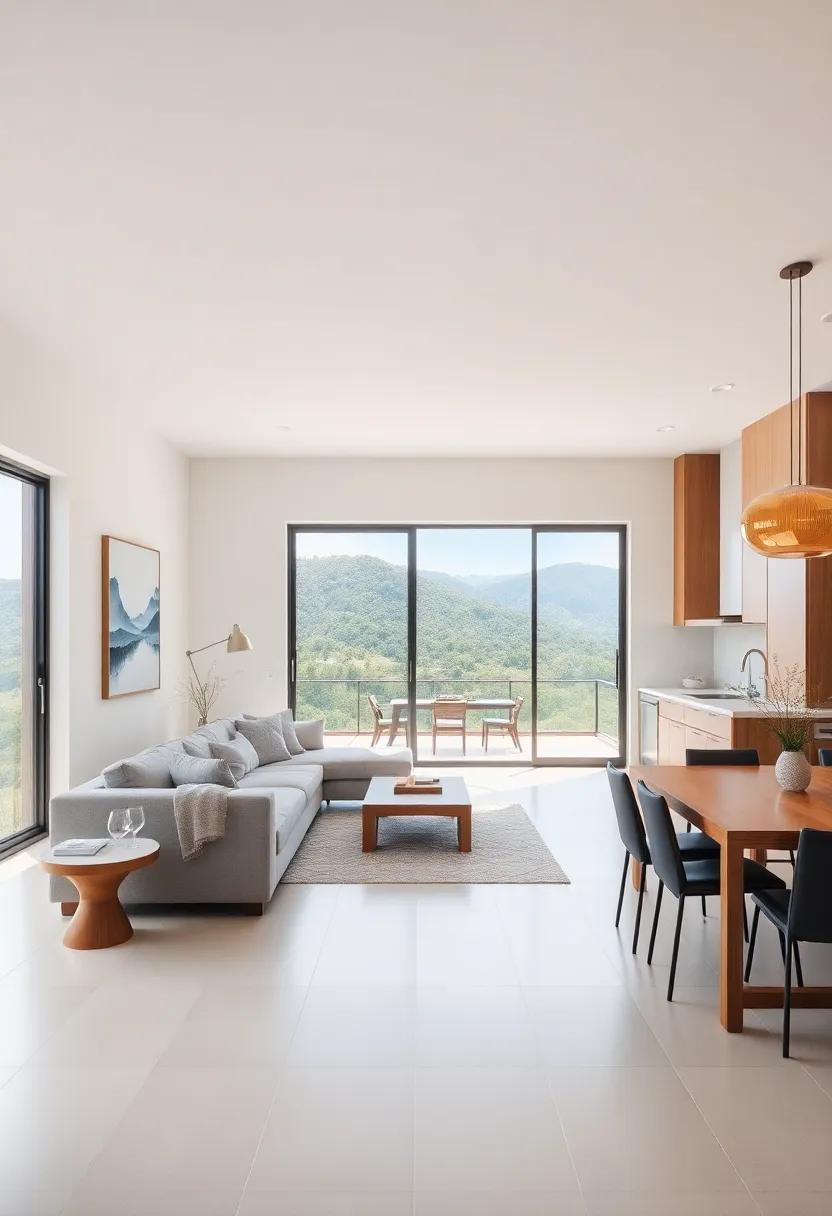
Sliding doors not only serve as functional entryways but also transform the aesthetic of your living space by framing stunning views.They allow natural light to spill into the room, creating an inviting ambiance while seamlessly connecting the indoors to the great outdoors. When strategically positioned, these doors can draw your eye toward breathtaking backdrops—be it a lush garden, a sparkling pool, or an intriguing cityscape. This dynamic interaction invites the landscape into your home, effectively blurring the lines between your living spaces and nature.
To enhance this synergy, consider incorporating design elements that complement the scenery they frame. Choose materials and colors that harmonize with both your interior decor and the external environment. Here are some thoughtful ideas to elevate your space:
- Frameless designs: For unobtrusive views.
- Sliding panels: To adjust light and privacy.
- Decorative hardware: that adds a touch of elegance.
- Textured glass: For a stylish, yet functional touch.
| Material | Benefits | Considerations |
|---|---|---|
| Aluminum | Durable and low maintenance. | May conduct heat or cold. |
| Wood | Warmth and aesthetic appeal. | requires regular maintenance. |
| Vinyl | Energy-efficient and affordable. | Less customizable. |
Optimizing space: Innovative Furniture Arrangements in Open Concepts
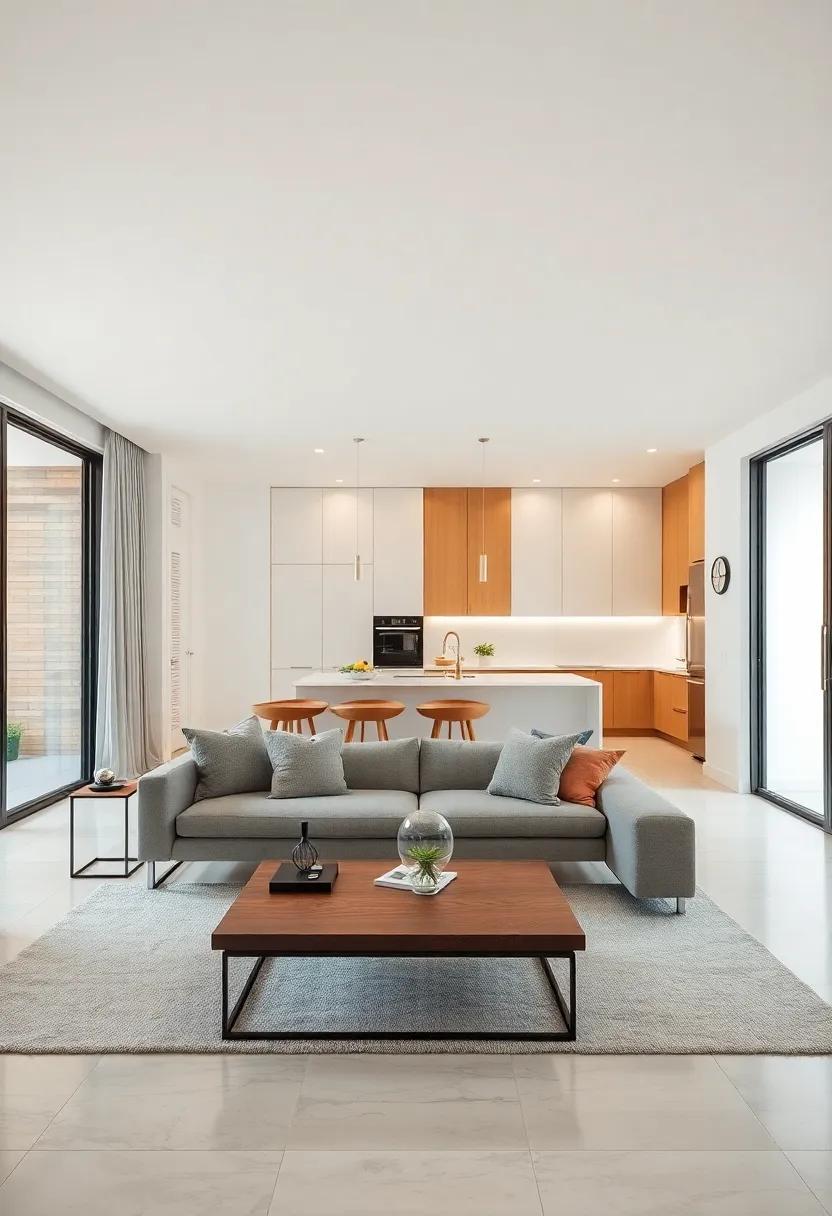
Creating harmony in an open concept environment requires innovative furniture arrangements that foster both functionality and style.Selecting multifunctional pieces can play an essential role in achieving this balance,allowing for seamless transitions between living and dining areas. Consider these approaches to enhance your space:
- Zone definition: Use rugs to delineate areas, making it easier to distinguish between the kitchen and living room without creating physical barriers.
- furniture groupings: Arrange seating in conversational clusters that encourage interactions, while ensuring easy flow throughout the space.
- Vertical accents: Incorporate bookshelves or tall planters to draw the eye upward,adding dimension without encroaching on the floor area.
When it comes to utilizing sliding doors, they can serve as both a design feature and a functional element in open layouts. By selecting stylish sliding doors, you can still maintain the airy feel of your space while offering the option for privacy when needed. Here are some considerations:
- Material selection: Choose materials like glass for a light look, or wood for a warm ambiance, ensuring they complement your overall décor.
- Track design: Opt for sleek tracks that blend seamlessly into your walls, minimizing visual clutter.
- customization: Explore bespoke designs that reflect your personal style and fit your space perfectly.
Tranquil Ambiance: Sound Control Strategies for Open Living Areas
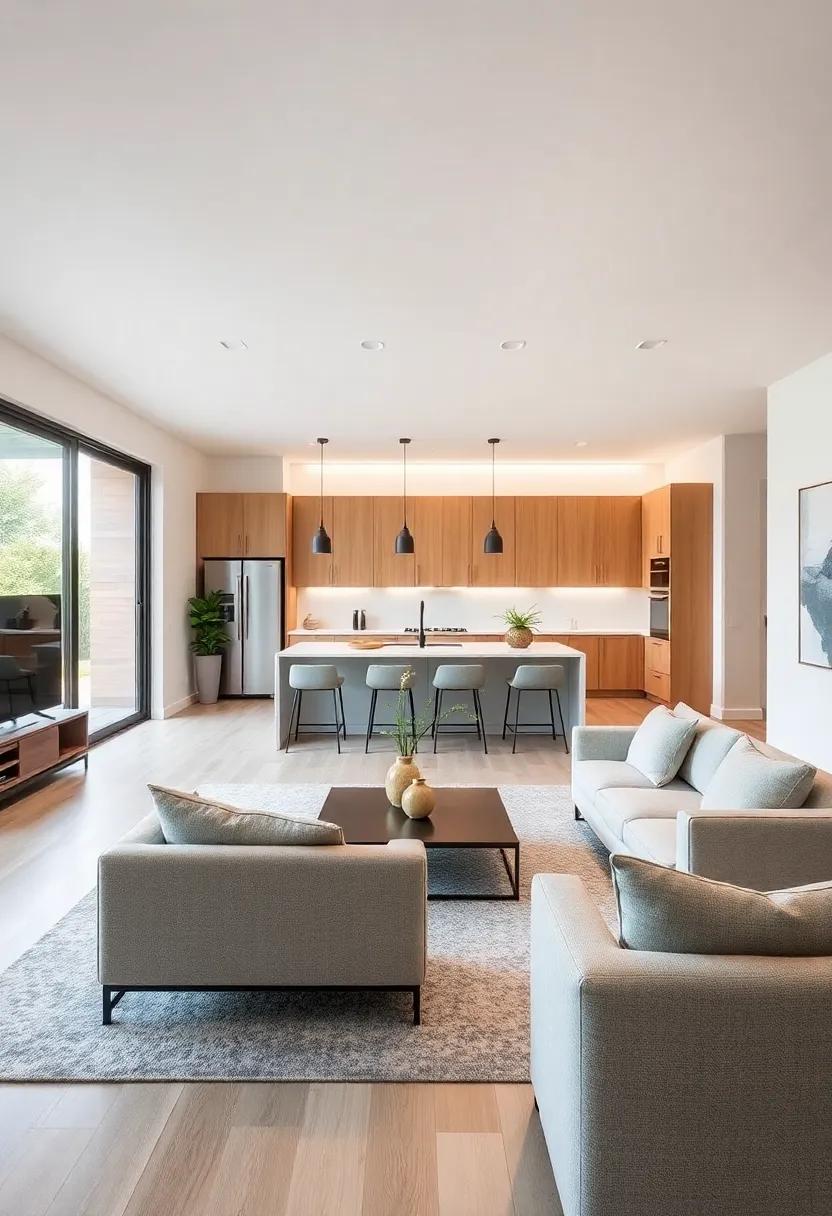
Creating a serene environment in open living areas begins with strategic sound control. By incorporating soft furnishings such as plush rugs,oversized cushions,and heavy drapes,you can effectively absorb sound and reduce echoes. Consider adding elements like acoustic panels or decorative wall hangings that serve both aesthetic and auditory purposes. Furthermore, layering textures within the space can help soften the overall ambiance, making it not just visually appealing but also peaceful to the ears.
Another approach to enhancing tranquility includes using strategic zoning with sliding doors. These versatile partitions allow for the flexibility of an open-plan layout while providing the option to create separate spaces when needed. Opt for sliding doors that offer sound-dampening features or enhanced seals to minimize noise transfer between areas. Integrating natural elements, such as plants, can further contribute to a calming atmosphere, promoting both sound absorption and visual tranquility. Below is a simple table highlighting effective strategies:
| Strategy | Benefits |
|---|---|
| Soft Furnishings | Reduces echo, adds comfort |
| Acoustic Panels | Absorbs sound, stylish decor |
| Sliding Doors | Flexible space division, sound control |
| Natural Elements | Improves ambiance, aesthetic appeal |
Cross-Functional Design: Merging cooking and Entertaining Spaces Seamlessly
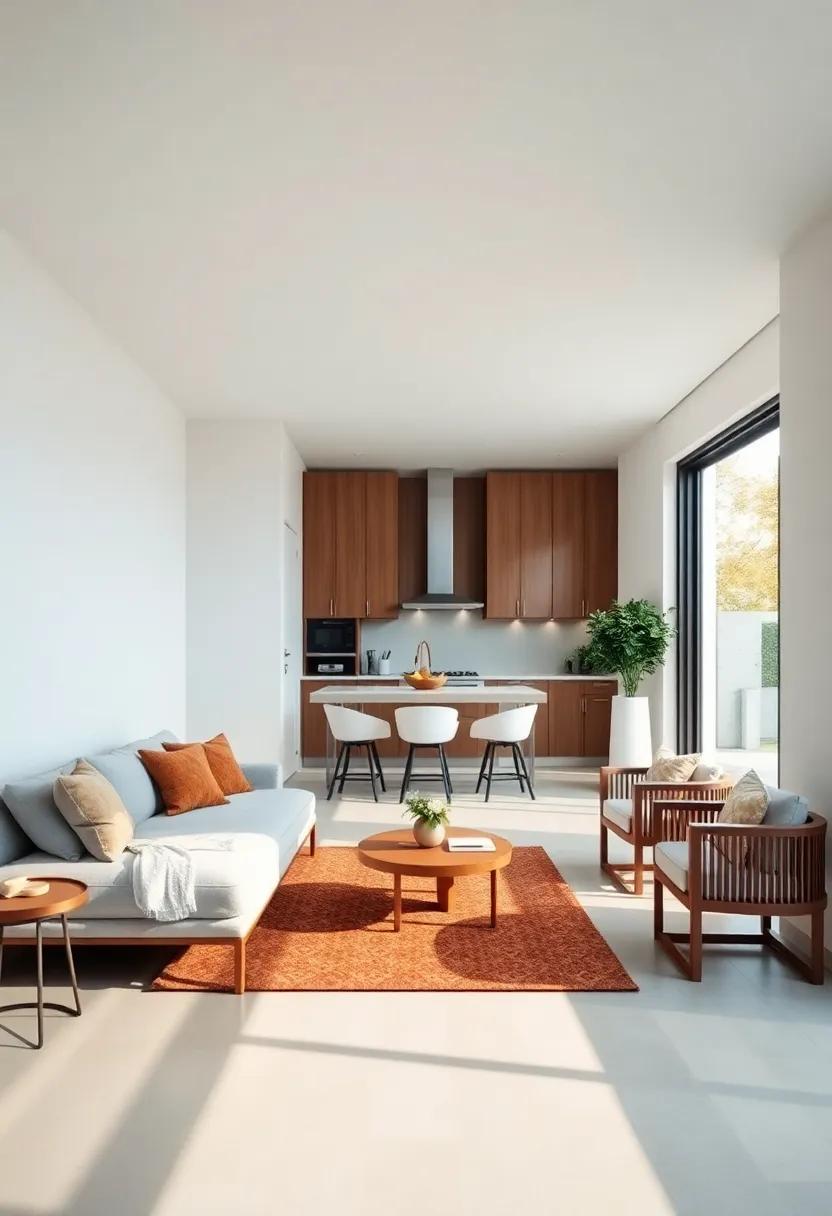
Creating a harmonious flow between cooking and entertaining spaces transforms daily routines into remarkable experiences. With the rise of open-concept layouts,homeowners are now embracing designs that facilitate both culinary creativity and socializing. Key features that contribute to this seamless integration include:
- Stylish Sliding Doors: These provide flexible boundaries, allowing users to transition between spaces effortlessly.
- Island Workstations: Central islands can double as meal prep areas and casual dining spots, fostering interaction.
- Unified Color Palettes: Cohesive color schemes throughout the kitchen and living area can create a sense of unity.
- Integrated Lighting: Layered lighting options enhance the mood for both cooking and entertaining.
When designing these combined spaces,consider the following elements for maximum functionality and aesthetic appeal:
| element | Functionality | Aesthetic Appeal |
|---|---|---|
| Countertops | Durable surfaces for cooking | Natural stone adds elegance |
| Furniture | Agreeable seating for guests | Stylish designs elevate style |
| Appliances | High-efficiency cooking | Modern finishes enhance decor |
maximizing Small areas: Open Concepts in Compact Homes
In today’s world of compact living,embracing an open concept design is essential for maximizing small areas. Such layouts create a sense of fluidity and spaciousness, making the entire home feel more inviting.By merging living rooms and kitchens, you not only foster a warm, communal atmosphere but also enhance functionality. The thoughtful integration of stylish sliding doors allows for effortless transitions between these spaces, giving you the flexibility to adapt your environment based on your needs. When closed, they provide privacy and separation; when open, they create an expansive area perfect for social gatherings.
Implementing an open concept design can be further enhanced by choosing the right furniture and decor.Consider the following elements to elevate your space:
- Multi-functional furniture: Opt for pieces that serve various purposes, such as ottomans with storage or foldable dining tables.
- Light color palettes: Using lighter shades can make areas appear larger and airier.
- Strategic lighting: Incorporate layered lighting with pendant lamps and sconces to brighten the entire area.
- Visual continuity: Use similar materials and colors throughout to establish a cohesive look.
| Design Element | Impact |
|---|---|
| Sliding Glass Doors | Facilitates light flow and visual connection |
| Open Shelving | Creates an illusion of depth and accessibility |
| Mirrors | Reflects light and enhances space perception |
| Integrated Technology | Simplifies functionality and reduces clutter |
Elevated Aesthetics: Choosing Stylish Finishes for Sliding Doors
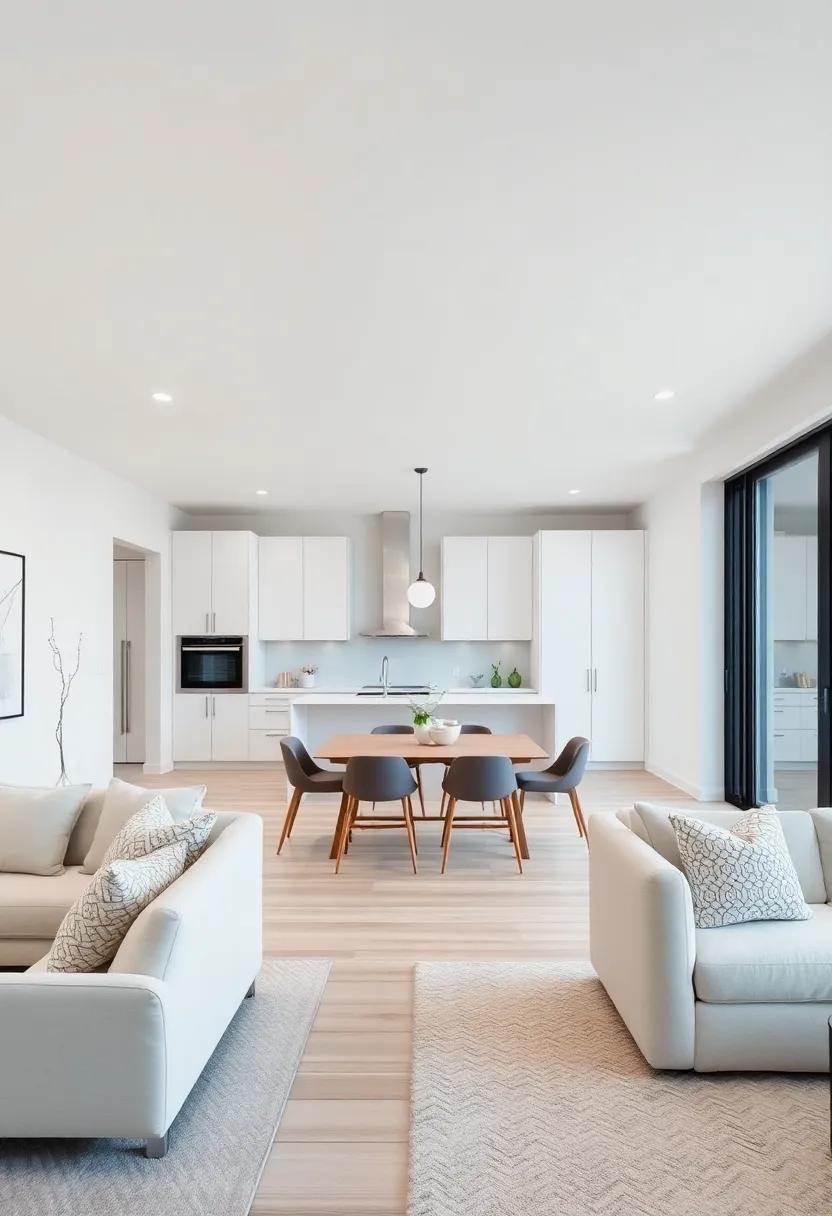
When selecting finishes for sliding doors, the ideal choice enhances the overall aesthetic of open-concept living areas while ensuring functionality. Consider materials that seamlessly blend with surrounding decor. Popular options include:
- Glass: offers openness and allows natural light to flood the space, creating an airy atmosphere.
- Wood: Provides warmth and texture, complementing rustic or modern styles alike.
- Metal: In matte or polished finishes, adds a contemporary edge and durability.
- Frosted or Etched Glass: Provides privacy while still allowing light to flow through.
The color palette of your sliding doors is equally importent, as it can either enhance or disrupt the visual flow between spaces. Neutral shades, such as whites, grays, and beiges, keep the design cohesive. Alternatively, bold hues can serve as focal points. When accessorizing these finishes, remember to consider:
| Finish Type | Best For |
|---|---|
| Clear Glass | Modern Spaces |
| Dark Wood | Traditional Decor |
| Brushed metal | Industrial themes |
| colored Glass | Contemporary Designs |
Embracing Minimalism: Simplified Design in Open Living Standards
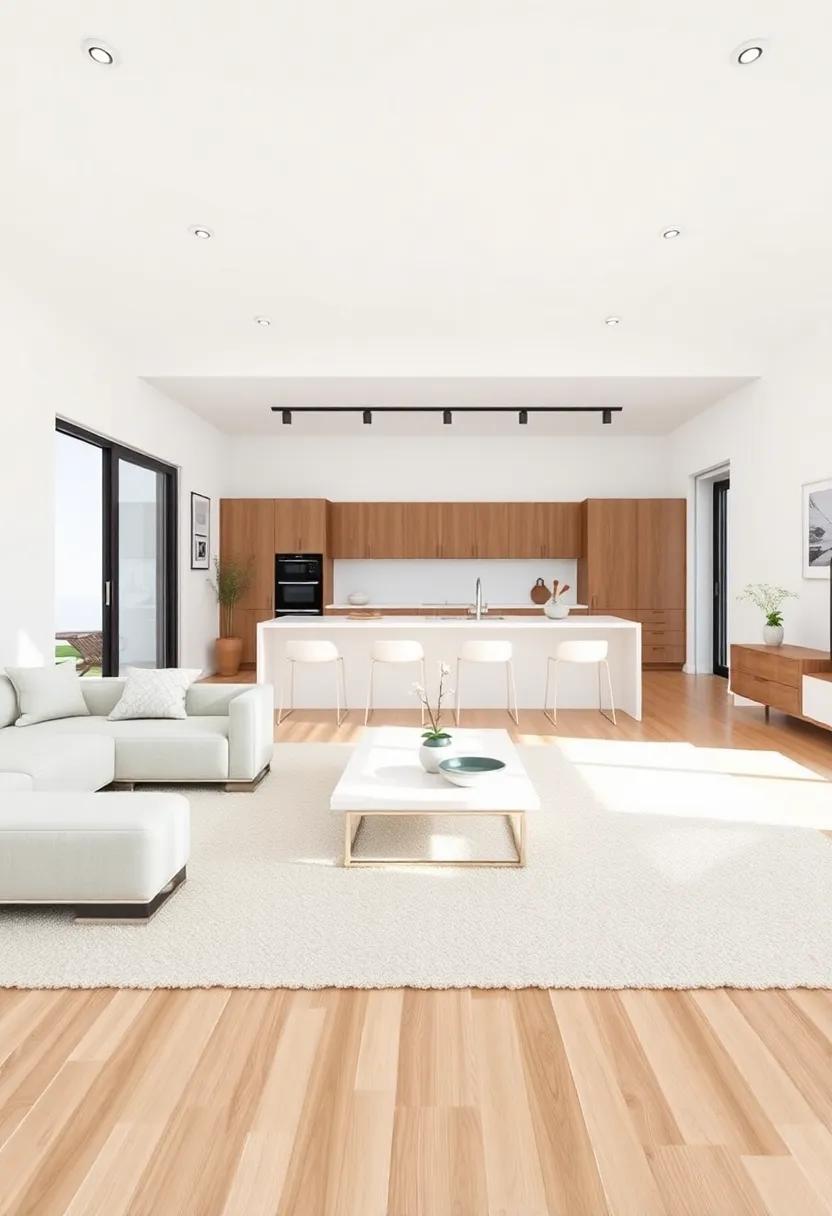
minimalism as a design philosophy encourages the removal of unnecessary clutter, allowing each element in a space to serve a purpose. In open living arrangements, this is crucial as it fosters a sense of unity and flow. A seamless aesthetic can be achieved through:
- Neutral color palettes to create a calming atmosphere.
- Sleek furniture with clean lines that do not overwhelm the space.
- Natural materials that emphasize organic simplicity and enhance connectivity with nature.
Incorporating stylish sliding doors is an innovative way to maintain the open concept while offering flexibility. These doors not only act as functional room dividers but also add a touch of elegance. factors to consider when selecting sliding doors include:
| Feature | Benefit |
|---|---|
| Material | Durability and aesthetic appeal. |
| Size | Customizable to fit various spaces. |
| Glass options | Allows light to flow while providing privacy. |
Creating Intimacy: Cozy Nooks within Spacious Designs
In the harmonious dance between spacious design and intimate comfort, creating cozy nooks can elevate your living experience.These small, inviting corners, adorned with plush cushions and favorite books, invite relaxation and personal reflection amid the open expanses of a modern layout. When nestled between expansive kitchen islands and airy living rooms, these tucked-away spaces offer a welcome retreat from daily bustle, achieving a delicate balance of openness and coziness.Consider incorporating elements like:
- Soft lighting: Warm pendant lights or decorative sconces can enhance the mood.
- Textured fabrics: A mix of throw pillows and blankets adds warmth.
- Personal artwork: Display cherished pieces to evoke nostalgia and connection.
Moreover, integrating sliding doors into your design enhances both accessibility and versatility, beautifully framing these intimate areas while maintaining the openness of the surrounding space.Sliding doors can smartly define the boundaries of cozy nooks without overwhelming the open-concept aesthetic. Large glass panels can infuse much-needed natural light into these corners, making them feel even more inviting. To optimize the functionality of these spaces, consider a layout that includes:
| Feature | Description |
|---|---|
| Furniture Choices | Choose lightweight pieces that enhance mobility. |
| Color Schemes | Use calming colors that inspire relaxation. |
| Natural Elements | Add plants to invigorate the space. |
Biophilic Design: Bringing Nature into Your Open Living Experience
Incorporating elements of nature into your living space not only enhances aesthetic appeal but also promotes well-being. Natural light, organic materials, and greenery can create a serene environment within open living areas. Imagine tall sliding glass doors that invite the golden sunlight and fresh air, transforming your kitchen and living room into an oasis of tranquility. Complement these features with indoor plants, which purify the air and offer visual interest, bridging the gap between indoor comfort and outdoor beauty.
To maximize the biophilic aspects of your design, consider key elements when selecting materials and furnishings:
- Wood accents: Use reclaimed wood for flooring or furniture to bring warmth.
- Nature-inspired color palettes: Opt for greens, browns, and earthy tones to echo the environment.
- Natural textures: Incorporate linens, jute, and stone to add depth and tactile variety.
Creating a sanctuary through nature-inspired design not only nurtures your space but also enhances your lifestyle. By thoughtfully integrating these aspects into your open concept, you foster a harmonious balance that engages the senses and revitalizes your home.
The Role of Lighting: Enhancing Mood in Open Concept Rooms
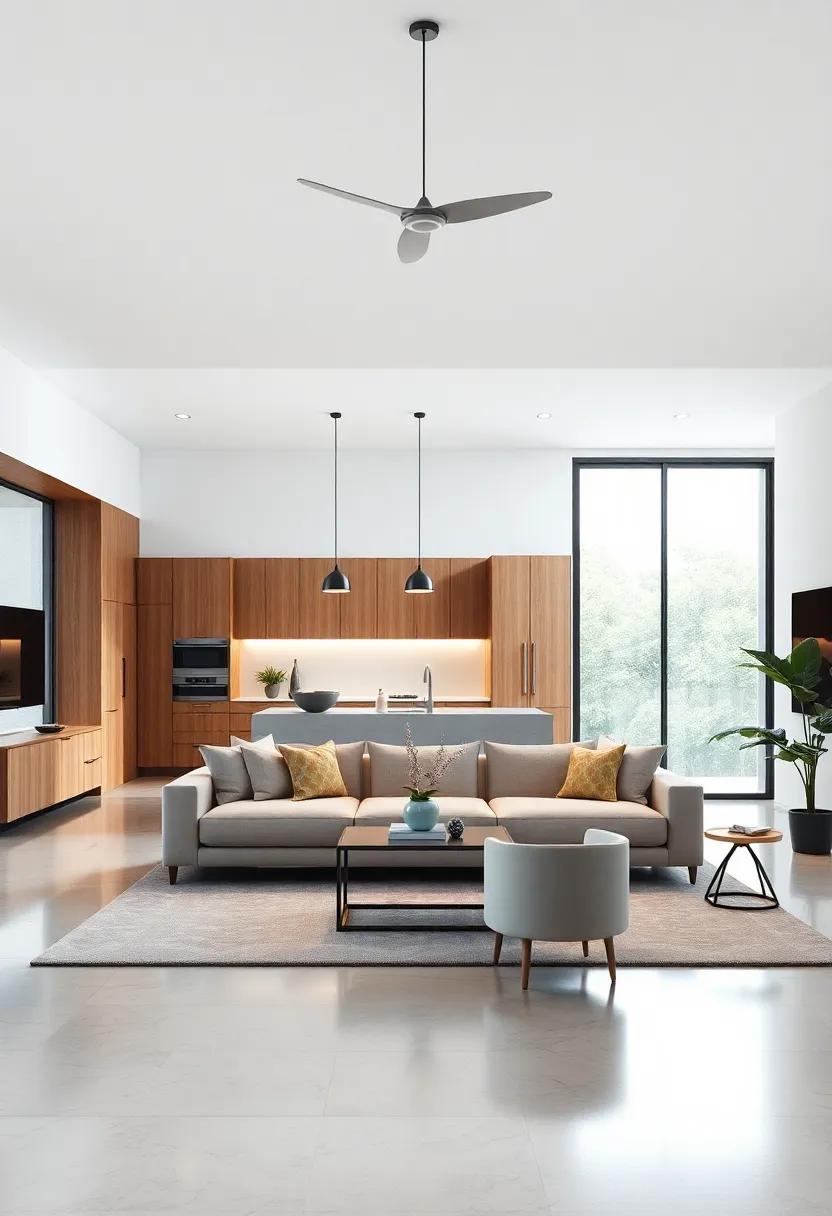
in an open concept setup, lighting becomes more than just a functional necessity; it transforms the entire atmosphere. Natural light plays a pivotal role,allowing spaces to feel larger and more inviting. Large windows, glass doors, and strategically placed mirrors can help amplify sunlight, creating a sense of warmth. To complement the natural light,consider incorporating layered lighting solutions—from ambient to task and accent lights. This combination not only ensures practicality but also adds depth and dimension, enhancing the overall aesthetic.
Moreover, the mood in these interconnected spaces can be significantly influenced by the choice of light fixtures. for example, soft, warm LED lights can evoke a sense of calm and comfort, ideal for family gatherings, while brighter, cooler lights may be more suitable for culinary activities in the kitchen. To achieve the perfect ambiance, homeowners can explore various lighting options:
- Pendant Lights: Great for drawing attention to kitchen islands.
- wall Sconces: Perfect for adding charm without taking up floor space.
- LED Strips: Excellent for highlighting architectural features or cabinetry.
Color Coordination: Harmonizing the Living Area and Kitchen
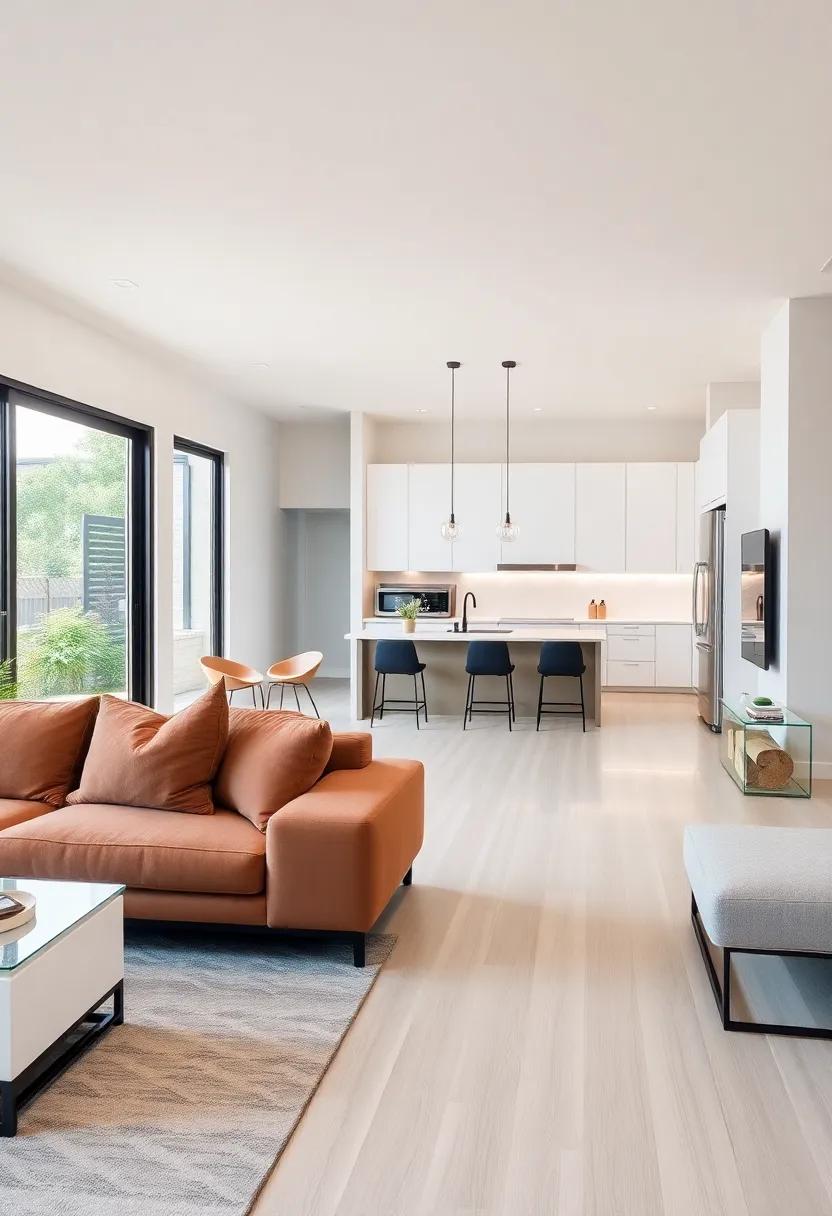
When designing an open-concept living area that flows seamlessly into the kitchen,color coordination plays a vital role in unifying the two spaces. Consider a palette that speaks to both the functionality of cooking and the relaxation of lounging.Neutral tones like soft greys, warm beiges, and crisp whites can create a tranquil backdrop, making it easy to incorporate bolder accents. Add splashes of color through accessories and decorative elements, such as:
- Cushions in vibrant hues on the couch
- Artwork that reflects lively kitchen elements
- Dishware that complements the living area decor
To elevate the connection between the two spaces, consider using a cohesive design approach on walls and cabinetry. As an example, matching cabinet colors with wall paint can create an inviting flow that naturally guides the eye from one space to the next. You could also explore incorporating a consistent material palette, such as:
| Material | Use in Living Area | Use in Kitchen |
|---|---|---|
| Wood Finish | Furniture and shelving | Cabinetry and Countertops |
| Tile | Accent Walls | backsplashes and Flooring |
| Textiles | Curtains and Rugs | Table Linens and Towels |
Functional Focal Points: Designing Around Sliding Doors
In the context of open concept living spaces, sliding doors serve as both practical and aesthetic elements. They provide an effective way to define areas while maintaining a sense of flow. By integrating high-quality materials such as glass, wood, or metal, these doors can elevate the overall design of a room.Consider options that allow for natural light to permeate through without losing privacy. Here are some functional aspects to consider when designing around sliding doors:
- Space Optimization: Sliding doors take up less space than traditional hinged doors, making them ideal for tight spots.
- Visual Continuity: Clear or frosted glass offers a way to create an unobstructed line of sight, enhancing the openness of the space.
- Versatility: They can be used to separate rooms for more intimate gatherings or opened for a more communal feeling.
When planning for the incorporation of sliding doors, it’s essential to assess the surrounding furnishings and overall layout. Balance is key; consider using color and texture to create harmony. Such as, matching the door frames with adjacent cabinet finishes can provide a cohesive look. You might also explore a range of hardware finishes to add a touch of personality while ensuring functionality. Below is a simple table showcasing popular materials and finishes for sliding doors:
| Material | Finish |
|---|---|
| Glass | Frosted |
| Wood | Natural Grain |
| Metal | Matte Black |
Outdoor Living Integration: Seamlessly Blending Indoor and Outdoor Spaces
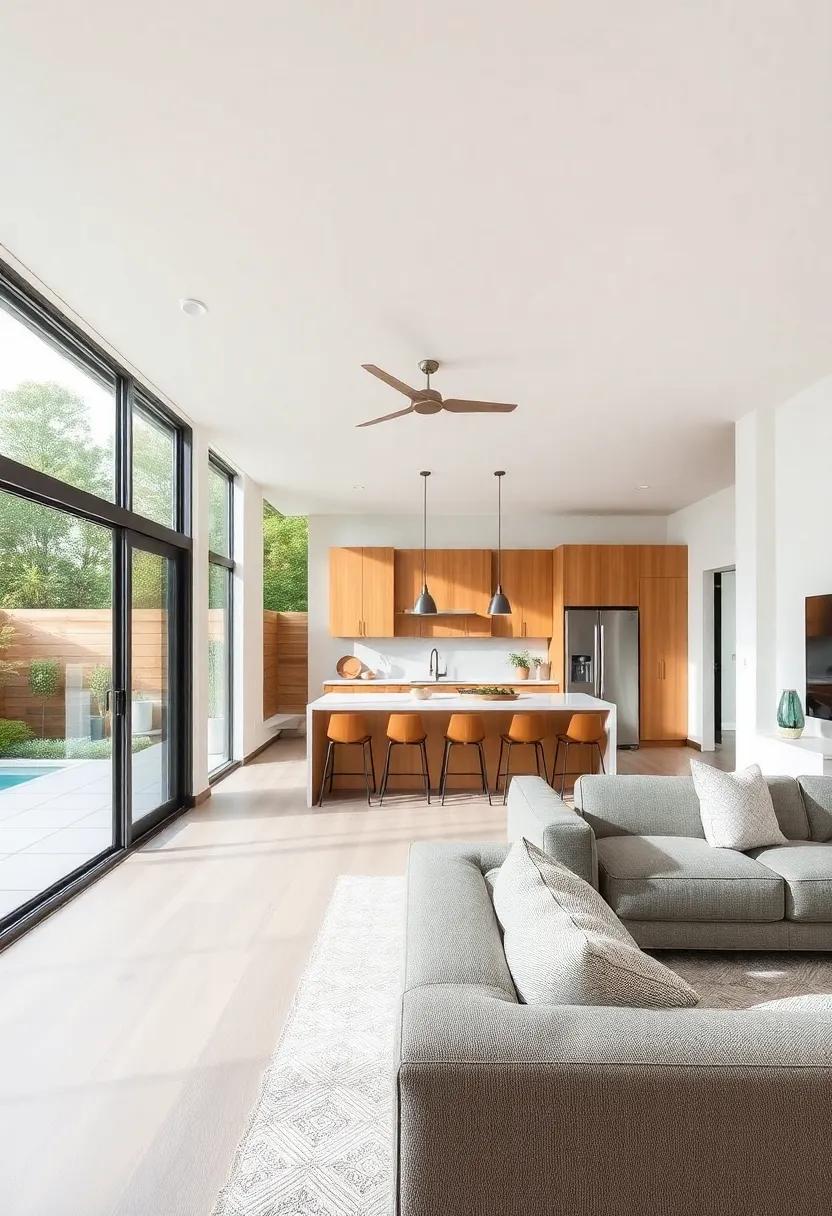
Incorporating outdoor living into your home not only enhances aesthetic appeal but also promotes a relaxed lifestyle. By using stylish sliding doors, you create an unobstructed flow between your indoor and outdoor environments. These expansive openings allow natural light to flood the interior while providing breathtaking views of the outdoor landscape. Imagine hosting a dinner party where guests can seamlessly transition from the kitchen to a charming patio adorned with twinkling lights and lush greenery, all without the disruption of traditional barriers.
To achieve a harmonious balance, it’s essential to consider color continuity and materials that connect both spaces.Here are some ideas for creating that seamless transition:
- Flooring: Use the same material inside and out, such as natural stone or composite decking.
- Colors: Maintain a cohesive color palette that mirrors outdoor hues within your indoor decor.
- Furniture: Select whether-resistant pieces for the patio that echo the style of the living room.
- Plants: Integrate potted plants that can be seen both inside and outside to enhance the connection.
The Versatility of Glass: Selecting the Right Type of Sliding Doors
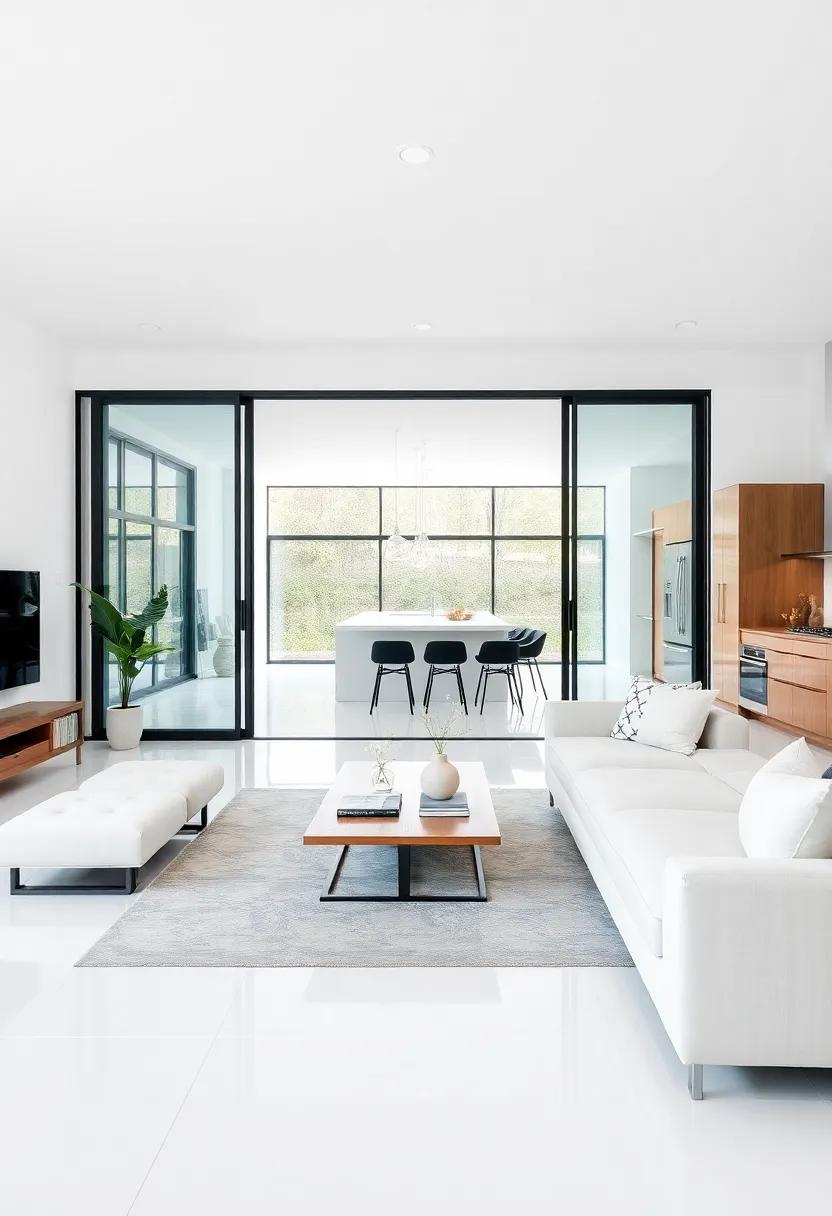
When choosing sliding doors, understanding the different types of glass options available is crucial for enhancing both aesthetics and functionality in your open concept living spaces. tempered glass is renowned for its strength and safety, making it an ideal choice for families. It undergoes a heating and cooling process that makes it five to six times stronger than standard glass, eliminating the risk of sharp shards in the event of breakage. In contrast, laminated glass provides additional security and sound insulation, as it consists of two or more panes of glass bonded together with an interlayer. This type not only protects against breakage but also reduces noise transmission, offering a quieter and more serene atmosphere in bustling homes.
For those seeking to blend beauty with energy efficiency, Low-E glass is a remarkable option. Its special coating reflects heat while allowing natural light to enter, helping maintain a comfortable indoor temperature year-round. Additionally,you might consider frosted or patterned glass for enhanced privacy without sacrificing light—perfect for areas that require a touch of separation while still feeling open. When selecting your sliding doors, it’s essential to balance style with purpose, ensuring that each type of glass complements your overall design while meeting your practical needs.
Incorporating Technology: Smart features for Modern Open Concepts
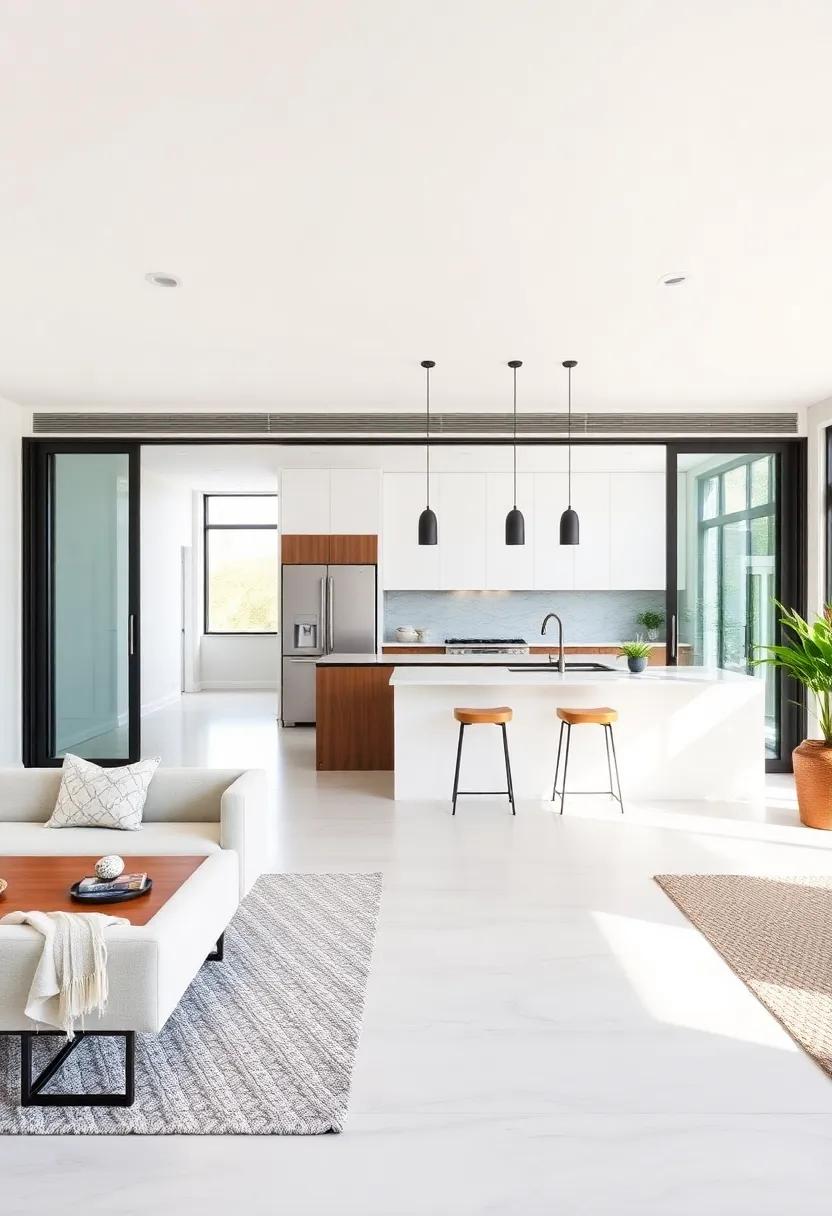
Integrating smart technology into open-concept living spaces revolutionizes the way we interact with our environment. Home automation systems can enhance convenience, comfort, and energy efficiency, creating a seamless experience between the kitchen and living room. Smart lighting, for instance, allows homeowners to adjust the ambiance effortlessly—whether it’s a cozy dinner or a lively gathering. Simultaneously occurring, smart thermostats learn your habits and optimize heating and cooling, ensuring that your space remains comfortable while saving energy.
Additionally, the implementation of integrated audio and visual systems can transform your open spaces into entertainment hubs. Imagine hosting friends for a movie night where the entertainment system is controlled with a single app. The advantages include:
- Multi-Room Audio: Sync music throughout your living room and kitchen.
- HDTV Integration: Mount televisions seamlessly for a sleek look.
- Voice Control: Command devices hands-free for ultimate convenience.
By harnessing these clever features, homeowners can blend functionality with aesthetic appeal, ensuring their spaces are modern, stylish, and tailored to their lifestyle.
Artful Ambiance: Accessorizing Open spaces with Elegance
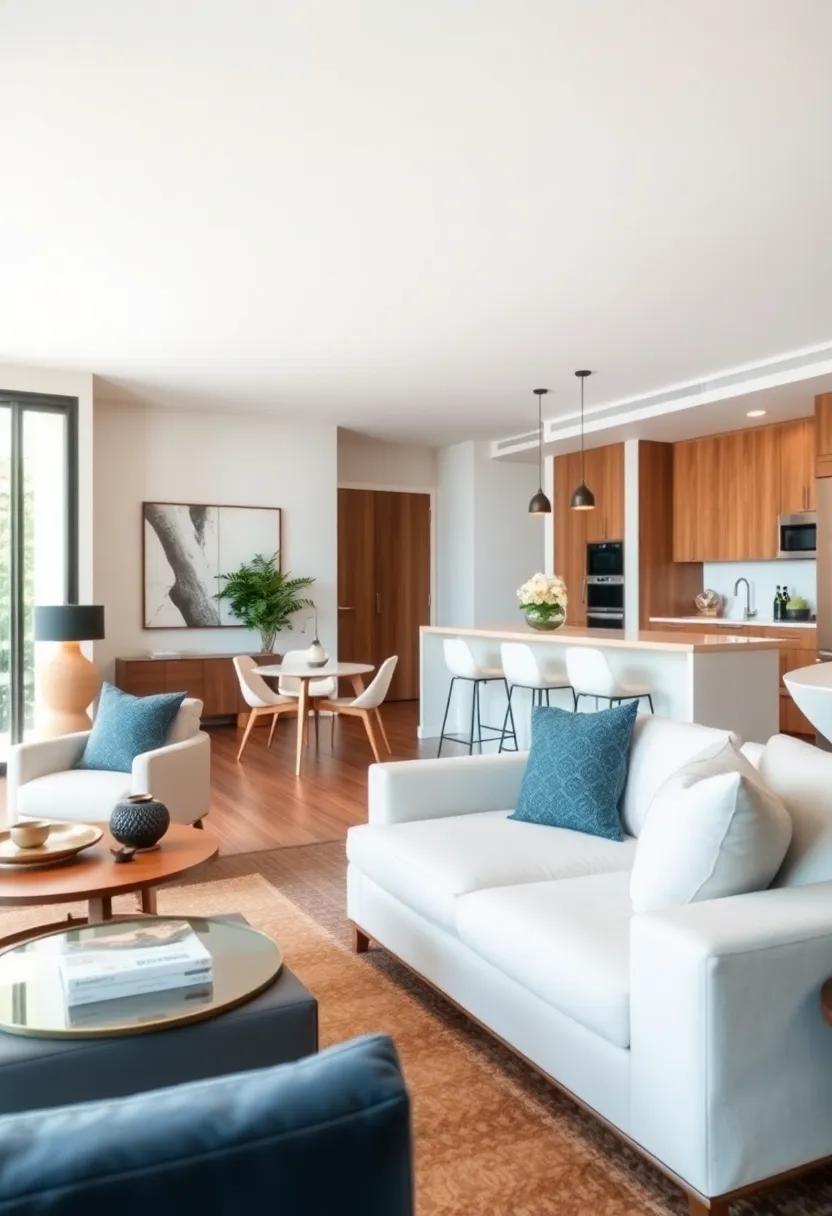
To enhance the fluidity of your open spaces while assuring a touch of sophistication, consider incorporating stylish accessories that reflect your personal taste. Elegant lighting fixtures, such as pendant lights and floor lamps, create a warm atmosphere and add visual interest.Pair these with textured rugs and artistic throw pillows that introduce color and depth,tying together the overall decor.Additionally, incorporating greenery through decorative plants can instantly elevate the ambiance, filtering the air and providing a natural element that softens the lines of furniture and architecture.
| Accessory Type | Function | Suggested Style |
|---|---|---|
| Lighting Fixtures | Enhances ambiance | Industrial, Modern, Vintage |
| Rugs | Defines space | Patterned, Textured, Neutral |
| Throw Pillows | Add comfort | Bold colors, Luxe fabrics |
| Plants | Brings nature indoors | Succulents, Foliage, flowering |
In open-concept living areas, the seamless integration of architectural elements such as sliding doors can transform your space into a gallery of style. These doors not only serve the functional purpose of dividing spaces but also act as statement pieces that complement the overall design.Choose designs with frosted glass or intricate woodwork that plays off other materials in the room, creating harmony. Consider a cohesive color palette that blends the interior and exterior,ensuring the transition from room to room is visually appealing. By thoughtfully accessorizing with elegant elements,your open spaces can exude both sophistication and warmth.
Balancing Open Concept Design with Privacy Needs
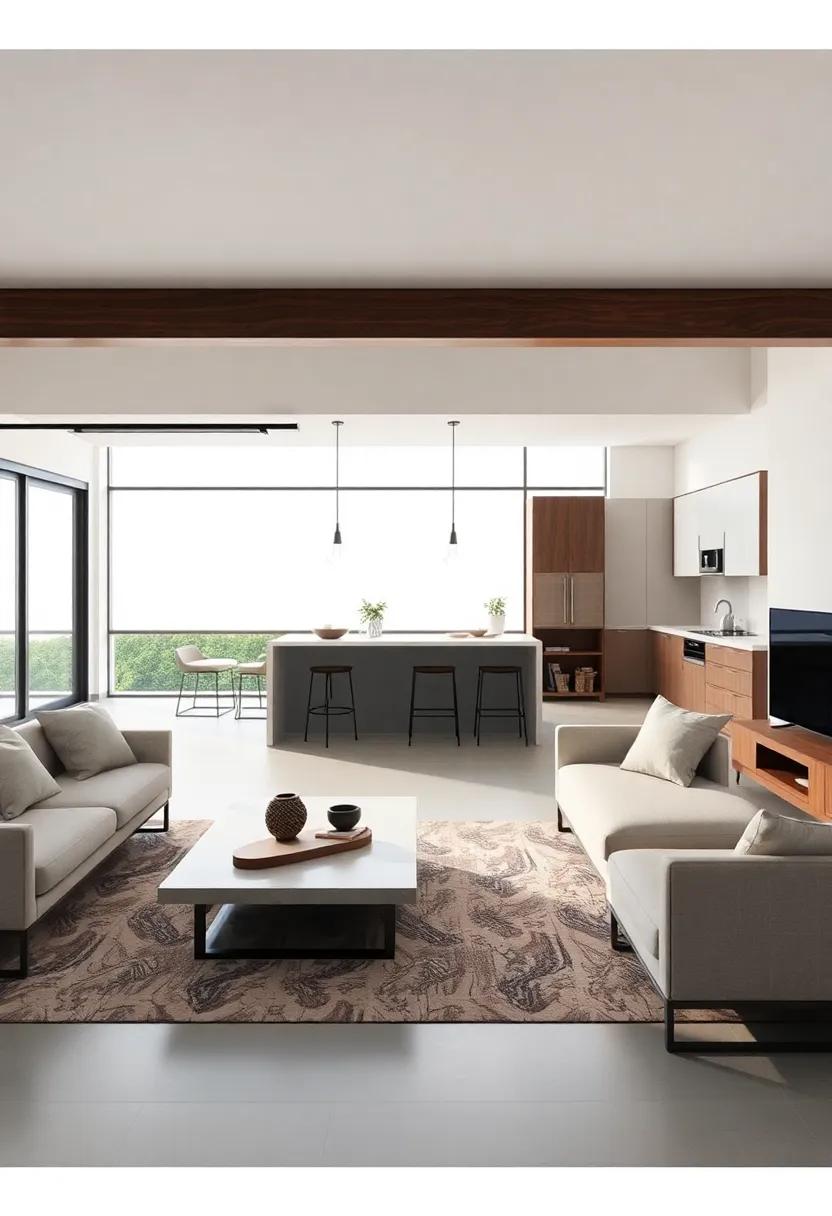
Creating an inviting open-concept area can sometimes feel like a double-edged sword. While it allows for spatial fluidity and makes areas feel larger, it also raises concerns about privacy, especially in busy households. To strike a balance, consider integrating stylish sliding doors that can transform a wide-open space into a more intimate setting when needed. These functional pieces not only serve as physical barriers but also act as design elements that add elegance to the overall decor.
When selecting sliding doors, it’s vital to contemplate materials and aesthetics that complement your interior while providing adequate separation. Here are some points to consider:
- Material Effect: Glass doors can create a sense of openness while allowing natural light to flow, whereas wooden sliding doors offer warmth and sound insulation.
- Color Palette: Choose hues that blend seamlessly with your existing decor to maintain a cohesive look.
- Hardware Styles: Opt for sleek, modern handles or vintage-inspired hardware to match your home’s character.
To assist in visualizing how sliding doors can enhance both openness and privacy, refer to the following comparison of different materials:
| Material | Pros | Cons |
|---|---|---|
| Glass | Light diffusion, modern look | Less privacy, requires cleaning |
| Wood | Warmth, good insulation | Heavier, can block light |
| Composite | Durability, cost-effective | Limited design options |
By thoughtfully coordinating these elements, you can achieve a space that feels both open and welcoming, while also catering to your family’s need for privacy. The key is to embrace the versatility of sliding doors, allowing them to redefine your living experience without sacrificing the comfort of home.
Innovative Solutions: Creative Uses for Underutilized Open Areas
expanding the use of open areas can transform not just the aesthetics of a home, but also its functionality. By integrating stylish sliding doors, you can seamlessly transition between spaces, creating an airy and cohesive atmosphere. These doors can serve as a barrier or an invitation, depending on the desired mood. Imagine a bright kitchen that flows into a spacious living room, where innovative uses for corner nooks or unused wall spaces can include:
- A mini herb garden: Frame your sliding door with planters that provide fresh herbs for cooking.
- Gallery walls: Convert the space into a dynamic art display that entertains guests and sparks conversation.
- Workspace integration: Utilize an area near the kitchen for a compact workstation, equipped with a stylish desk that complements the design.
Implementing functional furnishings and smart storage solutions further enhances open areas. Multi-purpose furniture can adapt to various needs throughout the day, minimizing clutter and maximizing usability. Consider incorporating:
| Furniture | Functionality |
|---|---|
| Extendable dining tables | Accommodate guests and provide a casual workspace. |
| Sofa beds | Transform the living room into an inviting guest room. |
| Ottomans with storage | Keep blankets, magazines, or board games out of sight. |
Sustainable Features: Choosing Eco-Friendly materials for Sliding Doors
When selecting sliding doors for your open concept living spaces,the choice of materials can significantly impact both the aesthetics and the environmental footprint of your home. Reclaimed wood, as an example, not only adds a rustic charm but also reduces the demand for new timber, preserving natural resources. Additionally, materials such as bamboo are fast-growing and highly renewable, making them an excellent choice for those aiming for sustainability. Furthermore, modern sliding doors can be made of recycled aluminum, offering durability and a sleek look without contributing to environmental degradation.
To ensure a holistic approach to eco-friendly design, consider options that use low-VOC (volatile organic compounds) finishes and adhesives. This minimizes indoor air pollution, promoting a healthier living environment.In your decision-making process, keep in mind the following materials that marry style with sustainability:
- Bamboo – renewable, lightweight, and versatile.
- recycled glass – Elegant and reduces waste.
- Reclaimed wood – Unique character with a lower environmental impact.
- Fiberglass – Energy-efficient and can mimic other materials.
- Low-VOC paints and finishes – Better for indoor air quality.
To Wrap It Up
In the harmonious dance between openness and intimacy, seamless spaces crafted with stylish sliding doors beckon us to rethink the way we inhabit our homes. As we adapt to evolving lifestyles,these fluid designs offer a perfect blend of functionality and aesthetics,allowing families to connect while preserving moments of solitude.Whether you’re hosting gatherings or enjoying a quiet evening, the interplay of light and space transforms your living areas into versatile sanctuaries. as we move forward, embracing the beauty of open concept living not only enhances our environments but also enriches our day-to-day experiences. So, as you consider your next home renovation or design, remember that the doors you choose can unlock a world of possibilities, inviting a refreshing flow of life, style, and connection into your home. Embrace the journey to create your own seamless sanctuary, where every moment feels like a celebration of togetherness and individuality.
As an Amazon Associate I earn from qualifying purchases.
